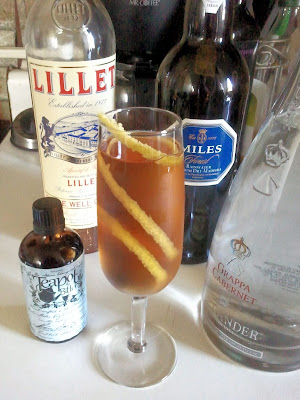...
Ok, maybe not as much resonance as the folks in Congress intended.
But! To close out a spectacular January by most likely gaining the blog's 5,000th hit as well as its first 1,000+ hit month, a little libation felt in order. That, and the general idea of a Cherry Alexio had been on the backburner for awhile and the timing seemed perfect, as far as occasion as well as proximity to Valentine's Day (plus, Peychaud's connection to NOLA's upcoming High Holiday, Mardi Gras).
*puts a lampshade on the transition's head, it's drunk and having a good time*
 |
| Mars lurks right behind on the track list. |
Rotorblade
1 1/2 oz cachaça (unaged, raw as a fresh Brazilian wax)
1 oz cream
3/4 oz Cherry Heering
1/4 oz coffee liqueur (I used the sultry Tia Maria)
2 dashes Peychaud's bitters
rinse of Black Sambuca
drops of Peychaud's bitters for garnish
Rinse a chilled cocktail glass with the sambuca.
Shake the first five ingredients with ice, then double-strain into the glass.
Decorate the foamy top radially with further drops of Peychaud's (recommend an eyedropper/toothpick for this).
Barring that it was a take on an Alexander, the original Alexio had some interesting points for using underexplored cachaça plus particular ingredients with numbers in their names (that's pretty much how I came to it, a year ago on National Brandy Alexander Day, to begin with). Adapting the flavor profile to cherry would mean an inexact line-up between ingredients, ratio-wise, and I wanted to go a bit further in interest level than simple cherry. (although I have to say, subbing Maraschino liqueur for the coffee liqueur makes for an excellent overall rounded cherry flavor, the full fruit and then the pomace)
So to start, for a creamy Alexander-style drink you want a cachaça that can let down its long curly mane, petrol notes and all, to make sure it comes through. 51's my stalwart standby, though Pitu is very comparable (I can't speak for any other brands, but anything LOUD should work just fine). With a cachaça like this, it's all so very primal and it would probably be foolish to not use that as the angle, what with the petrol notes: everything else just has to rise to their occasion.
As far as cherry flavor, where else do you go but the rich (but not overly sweet) Cherry Heering? I cut it back from a full ounce in order to work some sub flavors in: something dark, moody, chthonic; something with weighty bass notes. Peychaud's bitters was the first to pop to mind, and the cherry-anise link led me to black Sambuca: off to a good start -- a rinse here since even a quarter ounce would be tongue-numb overkill. While Maraschino was a nice mix, it wasn't dark enough. Working on this until the last minute, I happened to hop over to Chemistry of the Cocktail's very latest post as of yesterday, and the suggestion of coffee notes intermingling in another Cherry Heering cocktail pointed me towards coffee liqueur. (Really, with a dessert drink such as this, an after-dinner cordial is the likeliest fit and would balance with the Heering's slight lack of sweetness) Tia Maria is a good fit with its own character not getting lost; Kahlua may run a bit too sweet; I'm very curious to know how espresso-flavored Galliano Ristretto might work. Finally, to make this a little more approachable to drier palates, and tie all the flavors together, this is when I decided to add the Peychaud's as more than an aromatic garnish.
It comes together quite well, with an almost ethereal metallic void taste. While neither cherry nor anise dominate, the anise bonds intriguingly with the petrol notes into a metal spice. Baking spices, particularly cinnamon and allspice, could easily find their way into this concoction, but I'm happier for the restraint and novel flavors. The bitters function well to downplay the sweetness and ultimately all the ingredients get their due, ebbing in and out of the cream clouds. The name Rotorblade is a track off of my favorite all-time album: Juno Reactor's Beyond the Infinite, a sublime hourlong mix of Goa trance electronica from the mid-90s. With the metal, hypnotic anise, dusky cherry, and coincidental bitters pattern, it seemed a natural fit for the track. I could probably sip on these and commune with the music all day and night.





